BenQ W10000 – 1080p DLP Projector Review
BenQ W10000 – 1080p DLP Projector
Can this monster DLP projector deliver the goods?
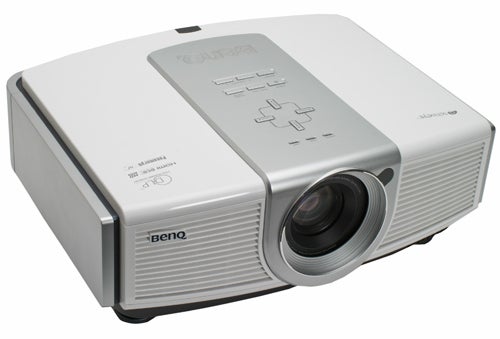
Verdict
Key Specifications
- Review Price: £4228.83
There’s no doubt that the world is going 1080p crazy. In the TV world, 1080p is the new black and the same is true for projectors. Not too long ago I reviewed Panasonic’s excellent, PTAE1000E, while recently, John was slightly disappointed with Epson’s TW1000. When it comes to 1080p though, these are relatively affordable projectors, coming in at around £2,000. This BenQ W10000 is a somewhat more expensive proposition, having an RRP of £5,000, and available at online retailers for around £4,500. At that price, it needs to be a lot better than the likes of the PTAE1000E and TW1000.
The BenQ employs a Texas Instruments 0.95in DLP chip, the DarkChip 3, with a native resolution of 1,920 x 1,080, which BenQ claims has a contrast ratio of 10,000:1. This is the only major difference to its sibling, the W9000, which offers 8.500:1. The BenQ features BrilliantColor, a marketing name that refers to the fact that the DarkChip 3 chip has an eight segment colour wheel. As such, it has cyan, magenta, and yellow on top of the basic red, green and blue delivering more subtle colour gradations. The wheel has a neutral density green (NDG) filter, which BenQ claims minimizes green dot noise – green, as that is the colour to which the eye is most sensitive. The W10000 is also a very bright projector, with a claimed maximum figure of 1,200 ANSI lumens, making it one of the brightest in its class.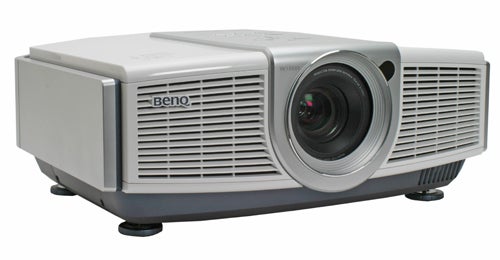
The W10000 is finished in white, silver and blue and the styling is functional but impressive. A lot of this is down to the fact that it’s a big ‘ol beast, measuring 349 x 120 x 277 and weighing in at 3.9Kgs. It’s really designed to be securely ceiling mounted for fixed installations and is certainly not the sort of projector you’ll want to pop out of a cupboard and place on a table to watch the football.
The large lens in the centre dominates, with two large grilles on either side, and it chucks out quite a bit of heat, not surprising considering the size of the lamp and the brightness level. A large plastic cowling with the BenQ logo embossed onto is available, should you wish to hide the connections. Behind this you’ll find only a single HDMI connection, which is a bit on the lean side these days, so a switcher will almost certainly be needed if you have multiple sources. You also get a Component input, plus a horizontal and vertical BNC connections for RGB. You’ll also find S-Video and composite, perish the thought. There’s a 12V trigger for use with things such as motorised screens, and an RS-232 port.
The top of the projector is adorned with many logos for things such as Senseye, DCDi Faroudja, HDMI and Panamorph. The latter means that the projector is compatible with Panamorph’s range of anamorphic lenses. These are expensive add-ons that enable you get full resolution from 2.35:1 aspect ratio sources, which is very common in movies, without having to have black bars on the top and bottom. Of course this means that you then have an issue with 16:9 sources and require you that you have a 2.35:1 screen, but this is all explained on the Panamorph web site. 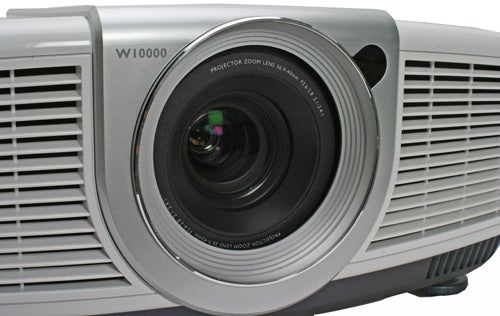
The buttons on the projector are all located on the central silver part above the lens. All of these are replicated on the remote control, which is what you’ll be using primarily. It’s not the very best remote I’ve ever seen but it’s good, with a button on the bottom providing an attractive orange backlight so you can see clearly what you’re doing. The buttons are also all nicely spread out so it’s easy to use.
There’s a good range of options available on the W10000 and many of them are directly accessible – input, aspect ratio, brightness, contrast, colour and tint. There are several presets designed for different lighting environments. These are Cinema, Home Theater, Family Room, Photo, and Gaming Mode. The preset button lets you scroll through them one at a time but it takes several seconds to move between each of them as the lens adjusts, which is a tad tiresome, but you can get to them directly through the menu as well. The iris is not dynamic, which will please the purists, but has several steps of manual adjustment, which you can get to directly via the remote.
One of the key features of the BenQ is that it has all the options that a professional ISF installer would need to calibrate the display. If you’re going to the expense of installing this in your home, it makes sense to get a qualified calibrator to get the best out of it.There are ISF Day and Night modes, so you can have your image perfectly set up for your viewing environment. These options are password protected once set, so can’t be messed with. 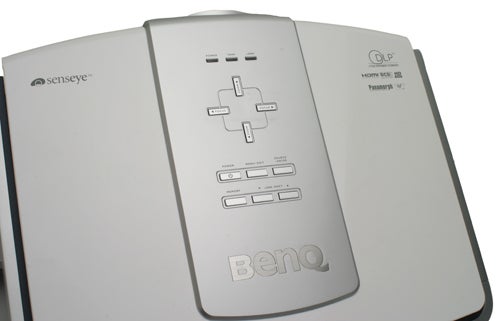
There are a great many options available if you delve into the setup menus. In the Advanced Picture options, you can choose between colour temperatures – Warm, Cool, Lamp Native and two user settings. You can boost individual colours, adjust sharpness and all of your options can be saved to presets. There is a Picture-in-Picture option too, but you can’t watch both an HDMI and Component source at the same time – you can only switch between one of those and S-Video and composite, so I’m not sure how useful the feature is.
Setup for the projector proved to be more difficult than with the LCD projectors – it doesn’t offer any horizontal lens shift, as Panasonic and Epson’s LCD projectors do. There is a vertical shift, but only to a limited degree. I tested with the projector on a table and found that it was difficult to get a even picture shape as the circular feet that rotate down we tricky to use. As I said earlier though, it’s really meant for fixed installations so in that situation, this will be a non issue.
What will be an issue is the fact that it has quite a long throw so I could only get a 70in image from around 2m back. On its web site BenQ has a nifty utility that will tell you how big an image you’ll get from what distance, and gives four metres as the minimum distance, producing a 100in image. What’s more, there’s only keystone correction on the X axis, which once again limits flexibility, though in a fixed install you’d want to avoid having to use keystone correction anyway as it can negatively affect resolution. Even so, these issues mean you need to check carefully to see whether the W10000 is suitable for your room.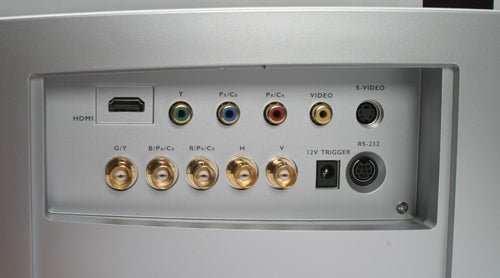
The projector takes about a minute to come on once you’ve pressed the button, which is something to get used to – projectors aren’t like televisions in that respect. It’s worth the wait though. The first thing I did was fire up some PES 2008 football action on the XBox 360. This is a good opportunity to talk about the noise level of the projector – it’s pleasingly quiet, even on full lamp mode, which outputs at 250Watts, but in the 200Watt eco mode, it’s even quieter. This is a boon when watching movies – the atmosphere of quiet moments isn’t going to be intruded upon.
The projector was quite happy to receive the 1080p 60 signal from the XBox 360, and immediately delivered a bright punchy picture even during the day in a non darkened room. This really makes a difference. If you think you’ll be using it in a room with ambient light then this is an important consideration. The Gaming preset does the job here, with the rich green of the pitch and the vibrant shirt colours all a delight to behold. 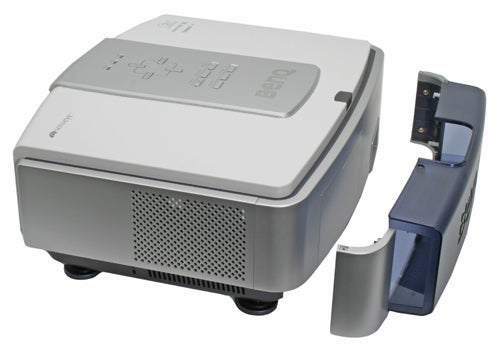
We then fed the projector a number of HD DVD discs from a Toshiba XE1, and revelled in the sharp, smooth and pleasingly colours. I’d describe the overall colour balance as warm, even on the Normal setting. The colours had a nice natural tone, without being over saturated, which can be a real distraction. Moving to the enhanced reality colours on the HD DVD of 300, the Ben Q did a fine job. The BenQ can handle the native 24fps input of the Toshiba XE1 and the presentation was suitably big, bold, smooth and judder free. I also had no issues with the dreaded, ‘Rainbow effect’ where you can see the colours make up the image, but then I have never been sensitive to this. The fact that the BenQ uses an eight segment colour wheel would help here. My only criticism would be that there was a touch more picture noise that I was expecting in the image.
We then moved on to the HD DVD of V for Vendetta, a good test for dark scenes. Shadow detail was impressive so were there any flaws in Natalie Portman’s skin, we would have seen it on the BenQ. In a completely dark room, with the Home Theater preset and the Lamp Iris setting turned down a couple of notches, the BenQ revealed itself to have a very good black level. However, I wouldn’t say it was as good as I hoped – certainly not Pioneer Kuro levels.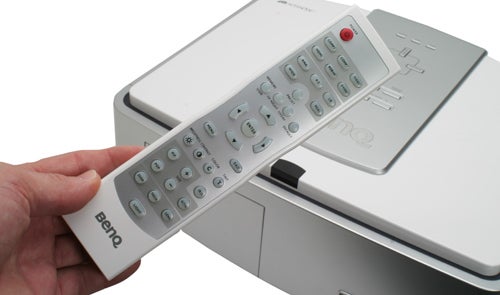
We then moved onto standard DVD – while HD sources are the best diet for an HD projector, the fact is that you’re likely to have a great many DVDs you’ll want to watch. Watching initially through an XBox 360 this led to the first area of disappointment in the BenQ’s performance. The difference with HD material was stark, with a noise and grain and a lack of detail evident on the discs we watched. It seems the Faroudja DCDi upscaling chip inside the W10000 is getting a bit long in the tooth. However, watching the same discs using the Toshiba XE1 HD DVD with its the Silicon Optix Reon upscaling chip, the projector delivered far better results. Using a decent upscaler then, the BenQ can be relied upon to deliver great results from DVD. Star Wars: Revenge of the Sith on was bursting with an amount of detail that was impressive for DVD.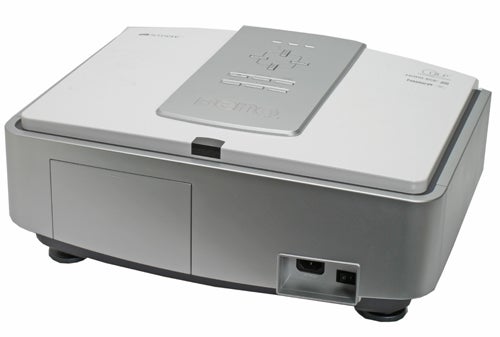
What interesting to see is that after a prolonged assault on DLP from competing technologies such as LCD, is why people actually pay more for a DLP projector. It’s simply produces the most cinematic images around – after all, actual digital cinema in your local multiplex is DLP based. Images on the BenQ were never anything less than punchy and vivid, offering natural colours and smooth motion, with a reassuring solidity to the image at all times.
However, all told, we were very impressed, if not quite blown away by the W10000. I did feel that I could have had an even deeper black level, a touch less noise, and far better in-built scaling processing. Practicalities such as an extra HDMI port would have helped its case too. 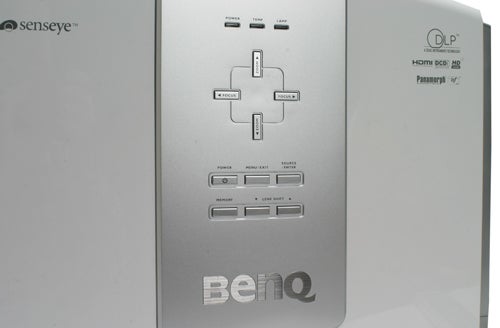
Essentially, I felt that while image quality was very good, I could not see it being worth an extra two grand over the Panasonic. It’s also got competition from rival DLP manufacturers, with the Infocus IN82 offering similar specs for only £3,000,
However, it seems that BenQ has answered these issues itself. It is about to release the W20000, which will hopefully answer the shortcomings of the W10000, with even better contrast, better processing and an extra HDMI port, and all for around a grand less. Meanwhile the lower specced W5000 will come in at under 2,000, which is record low for DLP. As such, the W10000, while impressive, is likely to be left on the shelf
”’Verdict”’
A large, impressive DLP projector, that really delivers on the image quality front, with a truly cinematic picture. It’s also very bright, so if you want to use it in a room with some ambient light, say for gaming, it does the job. However, it’s not the most flexible projector to set up, with a relatively long throw and limited lens adjustment. It’s also decidedly overpriced compared to the rest of the market, but BenQ has answered that itself with a cheaper and even better model around the corner.
How we test televisions
We test every TV we review thoroughly over an extended period of time. We use industry standard tests to compare features properly. We’ll always tell you what we find. We never, ever, accept money to review a product.
Trusted Score
Score in detail
-
Image Quality 9
-
Value 5

